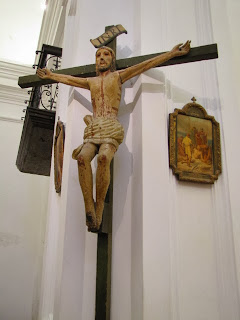 |
| For a day in the Cordobes Sierras, one heads to Candonga, about a couple of hours drive via tortuously winding mountain roads - mostly gravel or dirt, allowing sweeeping vistas of the Sierras. Candonga, and specifically Estancia San Gertrudis are located in a pleasant valley, where at its lowest point, a sparkling river feeds verdant forests and rich vegetable fields. |
 |
| After heavy rainfalls in previous weeks, the 'desert' of the surrounding hills and mountains is in bloom. |
 |
Estancia San Gertrudis despite its remoteness offers more than all the comforts of home. Beautifully kept grounds, swimming pool with bar and palapa covered porches (all totally dead today), parilla, posada, restaurant, small museum, all of which lend themself to wedding feasts, concert performances and small conferences.
A whole pack of friendly dogs has the run of the place and greets everyone with more or less desired doggy kisses. |
 |
| A little white washed chapel sits in the centre of the valley. |
 |
In the middle of nowhere, the Estancia offers varied services - however, the restaurant is only serving meals upon previous reservation...as the tour was geared to a 'cabalgata' (trailride) combined with an open air BBQ halfway through the ride,the restaurant was NOT open for business.
I had decided to let the small group to their horsey thing and remain behind (my knee would not have approved of a four hour ride) not knowing that I was concemned to starvation diet. However, one of the cleaning ladies took pity on me and found a Quilmes cerveza somewhere, a welcome relief on a day with 34 degrees heat. |
 |
| Is says 'abierto' - open - but not today |
 |
| A river runs through the property, and a hanging bridge leads from the swimming pool to the organic vegetable fields |
 |
| Midday heat, the sun almost straight above, and any spot if shade is welcome |
 |
| First time I ever saw horses being 'herded' just like sheep. The border collie was trained tofollow whistle commands and select a certain horse from the hill side and 'herd' it right through a little gate into this corrall. Then he would sit by the gate and make sure, the horse would not escape again. |
 |
Most of the horses living in the valley run free in the surrounding hill sides and graze there. But a number of horses, a couple of cows with their calves and a few sheep lived in a rock walled paddock, with plenty of water and sufficient shade.
|
 |
| One of two foals, which accompanied her mother who carried one of the guests on the trail ride. |
 |
| First time up - ever - this young boy from Finland stood in front of the horse and asked 'What do I do now' and Salvador, the gaucho tour guide, suggested to climb up 'gaucho style'. A bit of a challenge, as gauchos swing themselves into the saddle without the benefit of stirrups. Well, the kid climbed up 'tourist style', the mare had seen it all before, and her foal kept on snacking during the whole process |
 |
| And they are off into the hills |
 |
| Everything in bloom... |
 |
| There are so many converging dirt roads/paths that one may wander off into the surrounding hills for ever new vistas and hundreds of mountain flowers. I did not venture too far, as I did not want to get lost, especially in the deadening heat of the day. |
 |
| Staircase to give access to the chapel roof... |
 |
| Old horse and cattle barn, now used as a garage |
 |
| Left over from a Parilla |
 |
| Cloudless sky... |
 |
| A little golondrina (swallow) with beautiful long tail feathers |
 |
| Not much action on the main drag through the Estancia, here a gaucho leading a polo pony from its pasture to???? |
 |
| After a ride through valleys and mountains, rivers and dirt paths the trail-riders are back - none the worse for wear. |
 |
| Little bird leaving its nest of labouriously gathered twigs |
A quiet day, wandering around, exploring the village, watching birds and butterflies, smelling 'the roses'...





















































